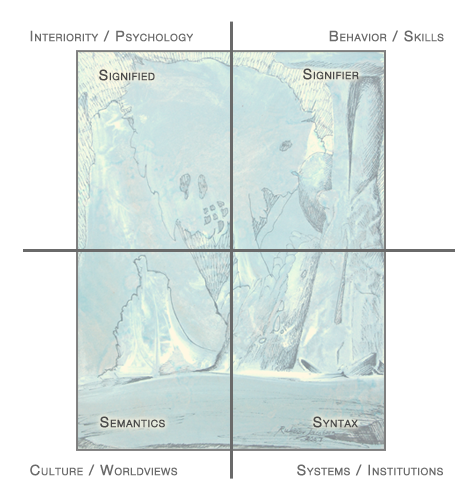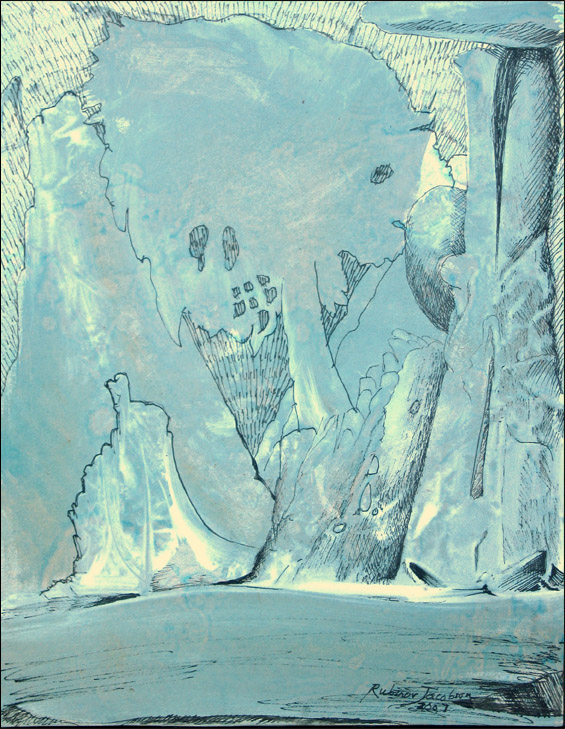|

As you read the following pointing out instructions, look at and feel into the drawing, opening up the given perspective on the artwork.
 [click image to enlarge]
[click image to enlarge] |
(Note: With regard to the drawing, the first two perspectives concern, for the most part, the content or the what; while the second two perspectives concern, for the most part, the form-and-materials or the how -- the ways the drawing “makes sense.”)
1 - Signified (UL)
The contents of the representation: the recognizable objects in the drawing, its individual motifs.
We see a tree, other forms indicating flora/rocks/ mountains; a background that is perhaps radiant sky, perhaps a distant element of the landscape itself; and a foreground of earth that, at right especially, indicates a ledge or plateau.
To be sure, the specific natural motifs are often allusive in this drawing, the same form open to multiple identifications, and in some places confounding scale (e.g., proximate rocks/ more distant mountains).
2 - Semantics (LL)
This perspective discloses the theme of the drawing and the semantic field or fields in which this overarching theme belongs. We reconstitute this wider semantic field by referencing texts on the theme and related pictures. (Traditionally this is the method of iconography).
The general theme of the drawing is nature and place; the pictorial genre landscape. We could read texts on the status of nature, as well as those on sacred places like Shambhala (which the artist mentions in his account of the drawing process). We could look at various traditions of pictorial landscape: including Western landscapes (which emerged during the 16th and 17th centuries), Asian landscapes, drawing and watercolor close-ups of nature (as the drawing plays on scale).
3 - Signifier (UR)
Individual elements of pictorial signification: size, scale, lines, shapes, color, value, format (shape of field), position of elements in the field, types of forms (delineated, painterly), boundaries of image-field and internal to the field, kinds of marks, materials.
(The artist’s account relays the physical size and materials of the drawing. [Note: any given material has a sensuous-feel and a distinctive not-easy-to-articulate expressive or affective quality.])
The field is a vertical rectangle (stressing the vertical rather than horizontal axis of perception). Shapes of the recognizable motifs are formed through external black contours lines. (Notice the qualities of these external contour lines – their thicknesses or thinness, amount of ink, rhythm-flow, and so on.)
Internal contours, minimal in this drawing, form shapes within -- as with openings in the tree-like motif. Other internal marks evince surface texture, shading, and apparent solidity. The marks forming the upper background are repetitions of a like mark, yet fluid and spontaneous in feel, each mark singular.
This upper background has a more or less uniform whitish ground. The inside of a number of the mid-level shapes have decisively painterly tones and hues: luminous and shimmering whites, blues, and pinks that radiantly, and mysteriously, dissolve or complicate the status of the form’s surface; in places “out shining” surface solidity altogether. With these painterly blotches we have an invitation to re-enact part of the artist’s own creative process: his looking into abstract forms and allowing recognizable realities to emerge.
4 - Syntax (LR)
Syntax is the wider arrangement, ordering, and patterning of the image-field established through the formal relationships amongst the visual elements (signifiers), picture light, and picture space (figure/ground; void).
The image-field as a whole is articulated into delineated areas through external contour lines, generating an interlocking and intersecting array of shapes. Inside any given delineated area is a distinctive pictorial rendering – from various modes and effects of line to blotches of shimmering tones and hues. Light, variously indicated, seemingly radiates outward rather than cast from an external source onto objects. Figure/ground relations shift and oscillate; with the foreground ambiguating its dimensions of depth and height.
The whole is dynamic, multivalent, and radiant: maintaining throughout compositional integrity.
-
 [click image to enlarge] [click image to enlarge] |
Practice moving into each perspective.
- Then back and forth amongst them, comparing and contrasting.
- Get a sense of the uniqueness of each. And allow the perspectives to affect one another, such that there is a deepening sense of their interplay.
- Notice that through this interplay there slowly emerges a sense of the integration of the what (UL, LL) and the how (UR, LR) of the drawing.
- There is no conclusive end to this expanding and deepening play of part and whole.
Click here after going through both the IP and IS sections. |

